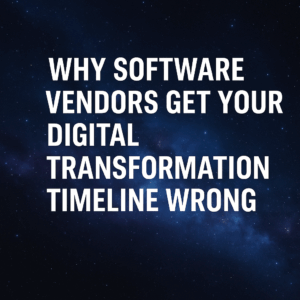Digital Transformations, or even enterprise technology initiatives are complex by nature. They generally touch nearly ever nerve in an organization, changing processes and altering the ways people have become accustomed to working. The concept of organizational change management (OCM) has grown in popularity over the past several years as organizations have come to realize that managing the people side of change is as important as, and often even more difficult than managing the technology changes.
Table of Contents
ToggleThe faults of typical organizational change management methodologies
Many of the change management techniques and methodologies recently have focused around managing individual or department level change. This is absolutely important as each individual in a group has their own, unique peculiarities and needs to be communicated, trained and managed in a way that will work for them as individuals.
But taking a step back, in any organization there are greater cultural effects that determine and drive how people work, how they react to situations and how business gets done. Look at your country, region or even neighborhood for example. I currently have family visiting for the Holidays from the Southern United States. While they are certainly very different characters in their own right, there are some strong commonalities driven by the culture of where they live. They all talk with a similar accent, they all like sweet tea and they are all accustomed to heat and strong humidity.
Influencing culture
While I could try to influence individual family members to prefer green tea or a cold environment, these cultural influences would be nearly impossible to change on a greater scale. If sweet tea sales were somehow banned as global health initiative for example, it would simply not go well. Even with advanced public communication and free trails of different unsweetened teas it would be an ugly situation. People would be angry and illegal brewhouses would pop up all over the place.
The same goes for any business or organization. There are cultural influences that need to be identified and accepted. You can possibly change, or at least manage individual differences to a certain degree, but you cannot change culture, especially during the course of an ERP implementation or digital transformation. To handle a change initiative effectively, first begin by adopting to the cultural assumptions, and then manage individual differences from there. Any timelines, communications, training and even technology platform will need to align with company culture.
Don’t expect users in a traditional top-down organization to openly share what they want in a new system, it’s not in their culture for users to drive decisions. You will certainly need to get this information to select and implement a new system, but find a more creative way and make sure that it is supported by senior management. If this is not done in accordance with the culture of the organization, process changes will not be adopted or supported, and the initiative will fail.
Culture reduces ERP implementation costs
To summarize, and for the controllers and CFOs who are still reading, here’s how this philosophy reduces overall cost of implementation: Simply put, it is more expensive to identify, manage and train individuals than it is a group. Starting by adopting to company culture, and then managing individual differences from there will save you $$$.
Learn more by downloading our eBook 20 Lessons from 1,000+ ERP Implementations.





